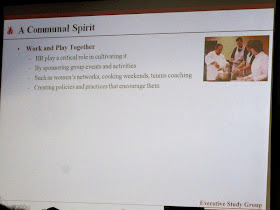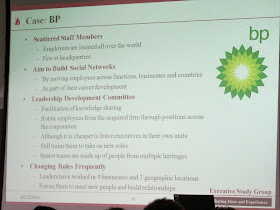In the beginning, Dr. Mark Lee explained what is collaboration in a team. He identified several goals of collaboration included "Share knowledge freely", "Learn from one another", "Shift workloads flexibly to break up unexpected bottlenecks", "Help one another complete jobs and meet deadlines" and "Share resource". Then he quoted Prof. Lynda Gratton statement.
He briefed the four factors of collaboration difficulty.
1) Size of a Team
When the size of the team increased beyond 20 members, the level of natural cooperation among members of the team decreases.
2) Virtual Participation
Teams became more virtual (e.g. Work at a distance from others), collaboration declined.
3) Diversity
The greater the diversity (e.g. Multiple background, age, knowledge), the less likely the team members were to share knowledge.
4) High Education Level
The more likely the team was to disintegrate into unproductive conflicts.
After that Dr. Lee asked us to perform self-assessment about the collaboration in your company. The more "Yes" selected, the less collaboration was in your company.
Dr. Lee introduced the 8 Ways to build collaborative team. There were under four domain included "Executive Supports", "Focused HR Practices", "The Right Team Leaders" and "Team Formation and Structure".
1. Investing in Signature Relationship Practice.
The top management commitment was the most important to create a "Gift Culture (無私奉獻文化)" and invested in Social Relationship Building (建立關係及情義). It was similar to BDTS division's Social Club or HKSTPC's Sport and Recreation Committee. Dr. Lee quoted some examples such as Royal Bank of Scotland (RBS) Group Business Improvement (GBI) Teams for short term project (e.g. 30-, 60-, or 90-day projects).
2. Modeling Collaborative Behavior
Dr. Lee explained how important of Role Model for collaboration. He used Chow Tai Fook as an example that top management were switching for regional heads, managers and functional heads. All team flied to Shenzhen monthly for face-to-face review meeting and training, so as to enhance mutual understanding.
3. Creating a "Gift Culture"
Dr. Lee quoted one of famous statement from Confucius, indicating that mentoring and coaching were important. Daily coaching helped to establish a cooperative "gift culture" in place of a more transactional "tit-for-tat culture (以牙還牙文化)".
Then Dr. Lee quoted Prof. Thomas J. DeLong's definition on a good mentor.
4. Ensuring the Requisite Skills
Dr. Lee said culture was not enough and HR should enhance the right skills such as training in skills related to collaborative behaviour and supporting for informal community building. Prof. Lynda Gratton suggested four crucial skill below that HR needed to be considered.
5. Supporting a Strong Sense of Community
Dr. Lee mentioned that HR played a critical role in cultivating Communal Spirit. He quoted Goldman Sach as example that their objective was to build relationship among different departments. They used incentives where all meals (included breakfast, lunch, dinner) were unlimited reimbursement for eating out with other department's colleagues but not for same department.
6. Assigning Team Leader that are both Task- and Relationship-OrientedDr. Lee suggested to use Task-Oriented Leadership first in the early stage and then use Relationship-Oriented Leadership (先對事,後對人。).
7. Building on Heritage Relationships
Dr. Lee emphasized "Trust" was very important to successful collaboration. Don't use 100% new member in the whole new team. The best mix was 20% to 40% of the team members who were already well connected to one another. BP was used as case study to explain.
8. Understanding Role Clarity and Task Ambiguity
Collaboration improved when the roles of individual team members were clearly defined and well understood. On the other hand, the task or path was ambiguous, team members were more likely to want to collaborate.
After introduced of 8 ways of collaboration, Dr. Lee reviewed the four domains which were key factors for effective collaboration.
After the seminar, we had an exercise to find out two of the most difficult things to do collaboration and one the least challenge for discussion.
Reference:
The Centre for Logistics Technologies and Supply Chain Optimization, CUHK: http://www.logitsco.cuhk.edu.hk/
HKSTP - www.hkstp.org















沒有留言:
發佈留言